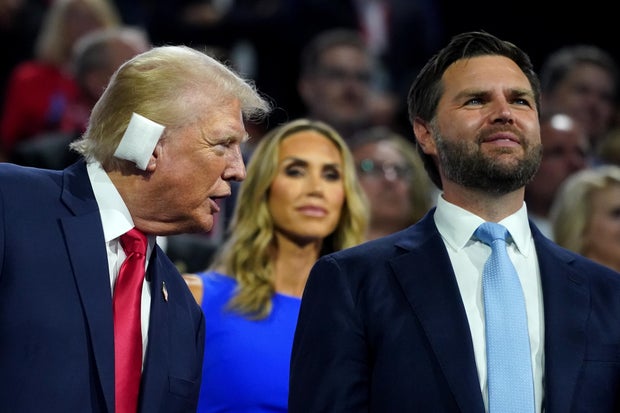
Washington — Donald Trump selected Sen. JD Vance of Ohio, a former detractor and now staunch ally, to be his running mate during the first day of the Republican National Convention on Monday, following months of speculation about who would accompany the former president on the GOP ticket.
The 39-year-old senator was first elected in 2022, six years after rising to prominence with the release of his memoir, “Hillbilly Elegy,” which recounted his childhood growing up in the Rust Belt. Initially an outspoken “Never Trumper,” Vance has since become a reliable defender of the former president’s record and vision, and his ascension marks the crowning of a would-be successor to lead a new generation of the party.
Vance can remain in the Senate while running for vice president, and would retain his seat if he and Trump lose in November. But if they win, he would have to give up his seat to serve as vice president, prompting questions about who would fill the vacancy.
Here’s how the Vance pick could impact the landscape in the Senate:
Al Drago/Bloomberg via Getty Images
Filling a vacancy in the Senate
State rules differ when it comes to filling vacancies in the Senate, but in Ohio, the governor appoints a replacement to serve until the next statewide election. In this case, Ohio Gov. Mike DeWine would appoint someone to fill the seat until a special election can be held in 2026. The winner would serve the remainder of Vance’s term, which ends after the 2028 election.
Notably, DeWine is one of the few prominent Republicans who have declined to endorse Trump’s reelection bid, and the two men have had a frosty relationship for years. It was the state’s lieutenant governor, Jon Husted, who nominated Vance for vice president at the convention on Monday, though DeWine was in attendance. If Trump wins in November, he will be losing a reliable fighter in the Senate with Vance’s resignation, and DeWine would be under no obligation to replace him with a Trump loyalist.
Adding to DeWine’s calculation is whether the appointment could hold onto the seat. While Ohio has lurched to the right in recent years, it’s still considered a competitive state, and DeWine’s appointment could tee up a major push by Democrats to flip the seat in 2026.
The party in control of the White House tends to perform poorly in midterm elections, and two senators who became vice president in recent history have seen their seats subsequently flip to the other party. Al Gore left the Senate to serve under President Bill Clinton, and his Democratic replacement in Tennessee lost to a Republican challenger in 1994. Democrats also lost the seat that had been vacated by Walter Mondale, who left the chamber to serve under President Jimmy Carter, in the 1978 election.
Tapping a running mate from the Senate
The Senate has been a frequent source for vice presidential picks since Franklin D. Roosevelt began the modern practice of presidential candidates selecting their own running mates, rather than leaving the decision to party leaders.
Among Democrats, the upper chamber has produced the bulk of running mates, according to Joel Goldstein, the nation’s leading vice presidential scholar. Republican presidential candidates have sourced their picks more evenly from the House, Senate, governors’ mansions and the executive branch.
For senators, leaving behind a coveted seat in the upper chamber was not always an obvious choice.
“It used to be that the vice presidency was kind of a political dead end unless the president died,” Goldstein said. “Beginning with Richard Nixon’s vice presidency, the vice president becomes the best political springboard in American politics.”
Goldstein explained that while Nixon was vice president, the role shifted from one primarily focused on presiding over the Senate to one that was pulled into the executive branch, with specific policy assignments for the president.
Under Carter, the office was further strengthened when he brought Mondale into the West Wing of the White House and made him part of his inner circle, Goldstein said. That tradition has since been followed by presidents of both parties.
“And so then the calculation becomes, not just that if you’re vice president it’s the best presidential springboard, but also it’s an important job,” Goldstein said. “You can do more as vice president, because you’re in the room, you’re part of decisions.”
Who could fill Vance’s seat?
A vacancy in Ohio would open up a wide field of possibilities for the appointment. Lawmakers like Reps. Dave Joyce, Mike Carey and Max Miller, who all currently represent Ohio in the House, are among those that could be considered. Husted, the lieutenant governor, could also be on the list, as could state Sen. Matt Dolan. And if Bernie Moreno, the GOP Senate candidate for Ohio’s other seat in the upper chamber, loses his bid in November, he could also be considered for the role.
Vivek Ramaswamy, who sought the GOP nomination for president before dropping out earlier this year and was born in Ohio, threw his hat into the ring after Trump announced Vance as his pick on Monday, telling CBS News in a statement that the only “negative” of Trump’s decision “is this leaves our side missing one of our best fighters in the Senate.”
“If asked to serve, I would strongly consider the position and would discuss with President Trump which path makes the most sense for our country,” Ramaswamy said.
With ample choices, how the Ohio governor will proceed, if given the opportunity, remains to be seen. DeWine praised Vance and celebrated the pick on Monday, telling CBS News that Vance is “a new generation” and “he’s exactly what we need.”
“It’s a great pick,” DeWine said.
Ed O’Keefe and Jake Rosen contributed reporting.






